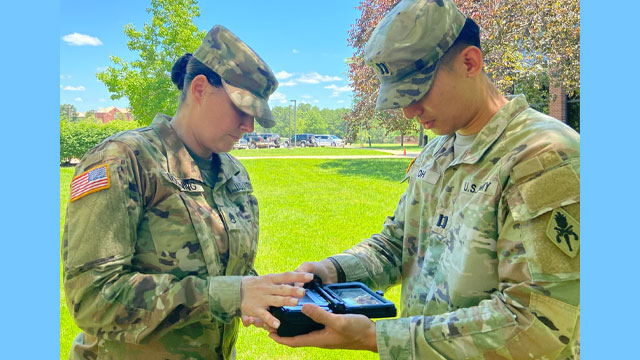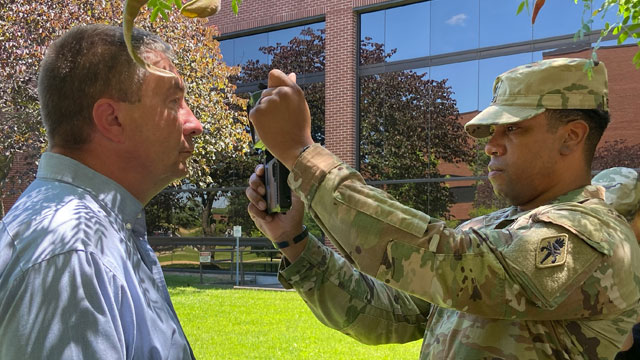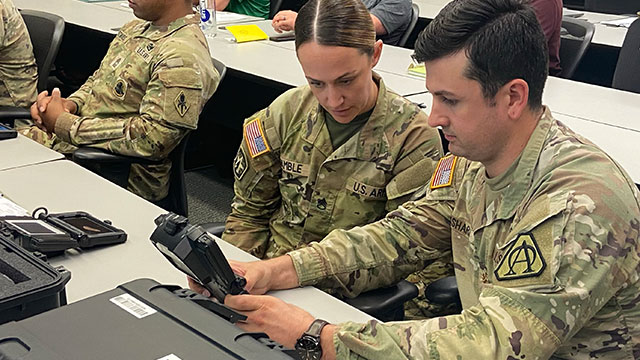By M. Scott Bortot |

Soldiers at Fort Leonard Wood provided feedback after working with Next Generation Biometric Collection Capability (NXGBCC) equipment. (Photo Credit: Esther VanCleave)

A Soldier performs an iris collection using a Next Generation Biometric Collection Capability (NXGBCC) mobile biometrics collection device at Fort Leonard Wood. (Photo Credit: Esther VanCleave)

Soldiers at Fort Leonard Wood provided feedback after working with Next Generation Biometric Collection Capability (NXGBCC) equipment. (Photo Credit: Esther VanCleave)
Soldiers at Fort Leonard Wood, Missouri, recently performed tasks using one of the Army’s newest biometrics technologies – the Next Generation Biometric Collection Capability (NXGBCC).
“This was the first real engagement for Army Military Police Soldiers for a mission that they’re taking on for the Army within large scale combat operations,” said Forrest Church, Product Manager for Biometrics. “It was a major milestone for the program and a great opportunity to get invaluable soldier feedback.”
NXGBCC is scheduled for fielding in 2025 and will incorporate fingerprint, iris, voice, and facial biometric modalities. The capability will be used to inform Soldiers of identities in near real time. This is the first time the Army is fielding a capability that is software-based with added voice modality and not tied to unique hardware that must be maintained.
The Fort Leonard Wood Soldier Touch Point (STP) gathered feedback from nine Soldiers on the effectiveness of NXGBCC devices. Soldiers performed tasks with NXGBCC equipment that includes both mobile collection devices and kits centered around a laptop for static operations.
“People say that feedback is a gift and there is no better gift for a Product Office than direct feedback from the Soldiers that will be using the equipment. Our opinion on whether NXGBCC meets their mission needs is not important. It’s their feedback that really matters,” Church said.
Participating Soldiers who lacked experience using biometrics collection equipment, with less than four hours of training on the two devices, found the devices to be easy to operate. They also reported that the devices would be easy to train.
The Soldiers performed the enrollments indoors and outdoors and in connected and disconnected environments to reflect real-use situations.
STPs like the one at Fort Leonard Wood provide a listening opportunity between engineers, product managers, and the people who employ the systems.
The Soldiers ran the biometric enrollments through the authoritative DoD repository for biometrics, the Department of Defense Automated Biometric Identification System (DoD ABIS). With NXGBCC, this process takes about a minute to return results from DoD ABIS, depending on connectivity. The previous requirement was for 15 minutes.
“The beauty was it provides a capability where you’re searching that submission [enrollment] against not only the 30 million encounters and over 13 million identities in DoD ABIS, but you’re also searching it against the largest unsolved latent fingerprint file in the government, 500,000 unsolved latent prints,” Church said.
During the two days of the STP, Soldiers performed enrollment tasks at six stations with assistance from engineers, first in disconnected mode, and then connected mode. Engineers worked with the Soldiers to elicit feedback and make any needed adjustments to the systems.
The Soldiers suggested ways to improve the systems that included adding additional web cameras, screen protectors for smartphones, and peripheral support to swipe identification cards to collect biographical information.
Product Manager Biometrics is assigned to execute NXGBCC under Project Manager Terrestrial Sensors (PM TS). PM TS procures, fields, and supports numerous state-of-the-art ground sensor systems globally, including within the United States at the southwestern border and in the National Capital Region.
NXGBCC will replace the Biometrics Automated Toolkit-Army (BAT-A) system used by the Army for two decades. NXGBCC enhances the biometric collection capability and identification speed compared to BAT-A.
The STP is part of a vigorous strategy to ensure NXGBCC’s success for the Soldier. Along with the STP, NXGBCC events include a Requirements Evidence Demonstration, Government Acceptance Test, and ICA-V Independent Security Control Assessor Validator.
Following the success of the Fort Leonard Wood NXGBCC, Church said USAMPS requested NXGBCC participate this August at the Titan Warrior exercise at Camp Shelby, Louisiana. The exercise will provide an opportunity for Soldiers to perform detainee biometric enrollment simulations using the system and peripherals.
“We’ll get more feedback from those folks on how they can integrate both biometrics and these devices into their operations,” Church said.

